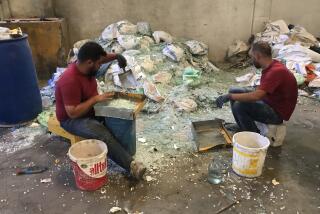New Light Shed on Ancient Egyptian Glassmaking
New excavations on the eastern Nile Delta show that ancient Egyptians had large-scale glass-making operations several hundred years earlier than researchers had believed, and the archeological remains provide the first solid evidence about how they did it, British and German researchers report today.
The glass factory at Piramesses, which probably began production around 1250 BC, about a century after the reign of King Tutankhamun, used a two-step process in which pulverized quartz was heated with plant ash in ceramic jars to form a crude solid.
Crushed again, the raw glass was heated to higher temperatures and colorized to form valuable ingots that were shipped to fabricators in Egypt and throughout the Mediterranean region, the research team reports in the journal Science.
âFor the first time, we can actually demonstrate that people made glass there and how they did it,â said archeologist Thilo Rehren of University College, London, one of the paperâs authors. âWeâre confirming what previously we could only guess about.â
Glassmaking is thought to have originated in Mesopotamia -- now Iraq and Syria -- about 1550 BC.
By 1250, the technology had improved substantially, although artisans could produce only opaque colored glass used to make small items such as perfume containers, figurines and other decorative objects.
Researchers knew that craftsmen at several sites in Egypt were working with glass ingots and using them to fabricate objects of art. But most assumed the ingots were brought in from Mesopotamia or elsewhere. A famous wrecked cargo vessel from about the same era discovered in the 1980s off Ulu Burun on Turkeyâs southern coast carried 175 such ingots, and researchers had assumed that they were destined for Egypt.
The discovery reported today, however, strongly suggests that the ingots were manufactured in Egypt and bound for the Middle East, said glass expert Robert Brill of the Corning Museum of Glass in Corning, N.Y. Remains of the ceramic vessels used to manufacture ingots at Piramesses were virtually identical to those found on the Ulu Burun wreck, Brill said.
âThatâs the context into which Thiloâs findings should be placed,â said.
The modern-day village of Qantir is the site of the ancient city of Piramesses, built by Ramesses II as the capital of northern Egypt. Rehren and his coauthor, Edgar B. Pusch of the Pelizaeus Museum in Hildesheim, Germany, have been working there for nearly two decades.
The region is a very flat area with a high water table and lots of agriculture, Rehren said. âItâs like [the British region of] East Anglia -- green, flat and boring.â Or, in American terms, like Kansas.
When Ramesses II built the city, he created a large glass workshop surrounded by domestic quarters, small temples and other buildings.
Pusch and Rehren have excavated only about 10% of the workshop area, Rehren said, but they have found the remains of hundreds of ceramic crucibles, each of which contained a glass ingot. They have also discovered ingots in the rawest stage, providing crucial clues about the production process.
Many historians assumed that sand was used as a raw material for the glass, but the excavation reveals that the Egyptians used quartz pebbles that were laboriously pulverized. Traces of the quartz grains remain in some of the crude glass they found.
The quartz was placed in used beer jars along with ash produced by burning native plants called halophytes, which thrive in regions with high salt concentrations in the water. When they are burned, their ash is about half soda -- a key ingredient in making glass -- and half rock salt. The ash and quartz were heated to about 1,650 degrees, forming a very raw glass.
After cooling, the beer jars were smashed to remove the primitive ingots, which were ground once again into a fine powder to remove air bubbles and washed with water to remove residual rock salt.
The powder was then poured into small-necked ceramic jars, using funnels that were found by the researchers, and heated again, this time to slightly more than 1,800 degrees. This heating stage required great skill, Rehren said.
âAnother 50 degrees hotter and the crucibles melt, and then you are in deep trouble,â he said.
To maintain the proper temperatures, the crucibles were wrapped in a ceramic fabric that served as an insulating barrier, the archeologists found. A small number of holes in the wrap toward the base of the jar allowed heat to reach the vessel. Clear evidence of these hot spots can be seen on shards from the jars, said Rehren, who called it a âvery cleverâ technique.
Coloring agents also were added to the glass at this stage. Workers at Piramesses specialized in making red glass. What the team now believes to be a similar workshop at Tell el-Amarna produced blue glass.
After it was cooled, the ingot was kept in the jar for shipping. Although there was probably some trade in ingots, Rehren said, they were mainly sent as gifts from one group of elites to another as a sign of high status.
The factory operated for only about 50 years before it was converted into a training and staging area for chariot troops, Rehren said. The pharaoh may have ordered a new glass factory to be built, he said, but if so, it has not been found.






